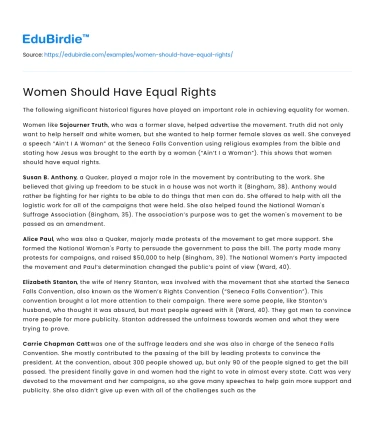The following significant historical figures have played an important role in achieving equality for women.
Women like Sojourner Truth, who was a former slave, helped advertise the movement. Truth did not only want to help herself and white women, but she wanted to help former female slaves as well. She conveyed a speech “Ain’t I A Woman” at the Seneca Falls Convention using religious examples from the bible and stating how Jesus was brought to the earth by a woman (“Ain’t I a Woman”). This shows that women should have equal rights.
Save your time!
We can take care of your essay
- Proper editing and formatting
- Free revision, title page, and bibliography
- Flexible prices and money-back guarantee
Susan B. Anthony, a Quaker, played a major role in the movement by contributing to the work. She believed that giving up freedom to be stuck in a house was not worth it (Bingham, 38). Anthony would rather be fighting for her rights to be able to do things that men can do. She offered to help with all the logistic work for all of the campaigns that were held. She also helped found the National Woman's Suffrage Association (Bingham, 35). The association’s purpose was to get the women's movement to be passed as an amendment.
Alice Paul, who was also a Quaker, majorly made protests of the movement to get more support. She formed the National Woman's Party to persuade the government to pass the bill. The party made many protests for campaigns, and raised $50,000 to help (Bingham, 39). The National Women’s Party impacted the movement and Paul’s determination changed the public’s point of view (Ward, 40).
Elizabeth Stanton, the wife of Henry Stanton, was involved with the movement that she started the Seneca Falls Convention, also known as the Women’s Rights Convention (“Seneca Falls Convention”). This convention brought a lot more attention to their campaign. There were some people, like Stanton’s husband, who thought it was absurd, but most people agreed with it (Ward, 40). They got men to convince more people for more publicity. Stanton addressed the unfairness towards women and what they were trying to prove.
Carrie Chapman Catt was one of the suffrage leaders and she was also in charge of the Seneca Falls Convention. She mostly contributed to the passing of the bill by leading protests to convince the president. At the convention, about 300 people showed up, but only 90 of the people signed to get the bill passed. The president finally gave in and women had the right to vote in almost every state. Catt was very devoted to the movement and her campaigns, so she gave many speeches to help gain more support and publicity. She also didn’t give up even with all of the challenges such as the lack of funds and support to start the organization.
These representatives of the Women's Suffrage Movement had a huge impact on subsequent generations.






 Stuck on your essay?
Stuck on your essay?

